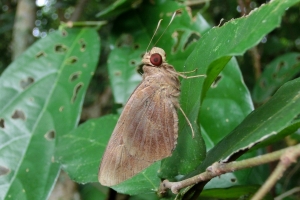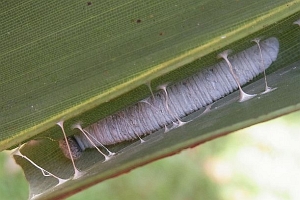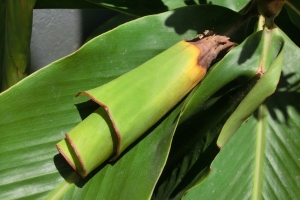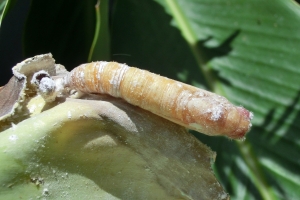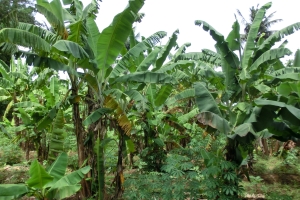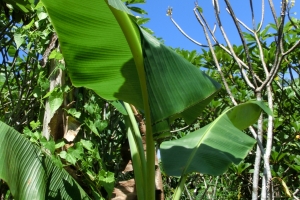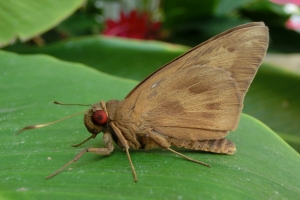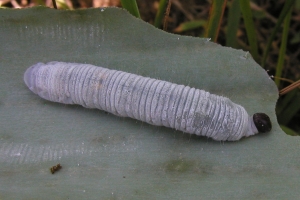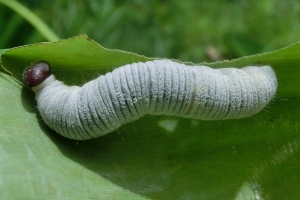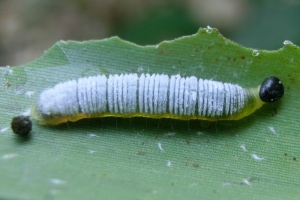

 +12Kontinente:ASNAOC
+12Kontinente:ASNAOC1. Lebendfotos
1.1. Falter
1.2. Raupe
1.3. Fraßspuren und Befallsbild
1.4. Puppe
2. Diagnose
Cock (2017: 7) betont, dass die Unterscheidung der Erionota-Arten schwierig ist und insbesondere die Meldungen von Erionota torus oft mit E. thrax vermengt wurden. Er empfiehlt daher in Gebieten, in denen mit beiden Arten zu rechnen ist, die Durchführung einer Genitaluntersuchung !
2.1. Erstbeschreibung
3. Biologie
3.1. Habitat
3.2. Raupennahrungspflanzen
3.3. Nahrung der Raupe
- [Musaceae:] Musa x paradisiaca (Banane)
- [Musaceae:] Musa textilis (Abacá, Faser-Banane, Textil-Banane)
Cock (2017: 7) berichtet: "I have found reports on the food plants and biology of E. thrax thrax only, and none on the other subspecies of E. thrax, although it seems likely that they will have a similar food plant range. In its indigenous range, many references (e.g. [15, 39, 73–77]) indicate that E. thrax feeds primarily on Musa spp. (Musaceae), especially banana (M. paradisiaca, = M. sapientum and M. paradisiaca) and M. textilis (abaca or Manila hemp). Sands et al. [58] surveyed E. thrax in PNG when it first spread through the island of New Guinea. They report collecting immature stages of E. thrax from Musa paradisiaca, M. textilis, other Musa spp. (including sections Australimusa and Eumusa) and several varieties. Waterhouse and Norris [45] point out that in its introduced range, E. thrax thrax is known only from cultivated and wild species of banana (based on personal communications of experienced entomologists who worked on the introduced pest), although their observation to this effect from Mauritius is actually based on E. torus. However, records from other recorded food plants, especially in the older literature, need critical examination. It is possible that different species of Erionota are responsible for the records on bamboo and palms."
Nach den Ausführungen von Cock (2015) beruhen Angaben zu diversen Palmen (Arecaceae), Bambus und anderen Gräsern (Poaceae), zu Heliconia spp. (Heliconiaceae), Curcuma angustifolia (Zingiberaceae) oder "traveller’s palm" (Ravenala madagascariensis: Strelitziaceae) sehr wahrscheinlich durchweg auf Fehlbestimmungen. So dürften sich die Meldungen zu verschiedenen Palmen meist auf Erionota acroleuca beziehen.
(Autor: Erwin Rennwald)
4. Weitere Informationen
4.1. Andere Kombinationen
- Papilio thrax Linnaeus, 1767 [Originalkombination]
4.2. Unterarten
- Erionota thrax hasdrubal Fruhstorfer, 1910 [Unterart nach funet.fi]
4.3. Faunistik
Nach [Global Biodiversity Information Facility] kommt die Art in Indonesien, Philippinen, Guam, Malaysia, Indien, Thailand, USA [Hawaii], Singapur, Papua-Neuguinea, Armenien?, Bangladesch, China?, Kambodscha, Myanmar, Panama? und Sudan? vor.
Locus typicus gemäß Erstbeschreibung: Java.
(Autor: Michel Kettner)
4.4. Literatur
- Cock, M.J.W. (2015): A critical review of the literature on the pest Erionota spp. (Lepidoptera, Hesperiidae): taxonomy, distribution, food plants, early stages, natural enemies and biological control. — CAB Reviews, 10 (7): 1-30. [PDF auf cabi.org]
- Erstbeschreibung: Linnaeus, C. (1767): Systema Naturae, Tom. I. Pars. II. Editio duodecima reformata. 533-1327 + unpaginierter Anhang. Holmiae (Salvius).













